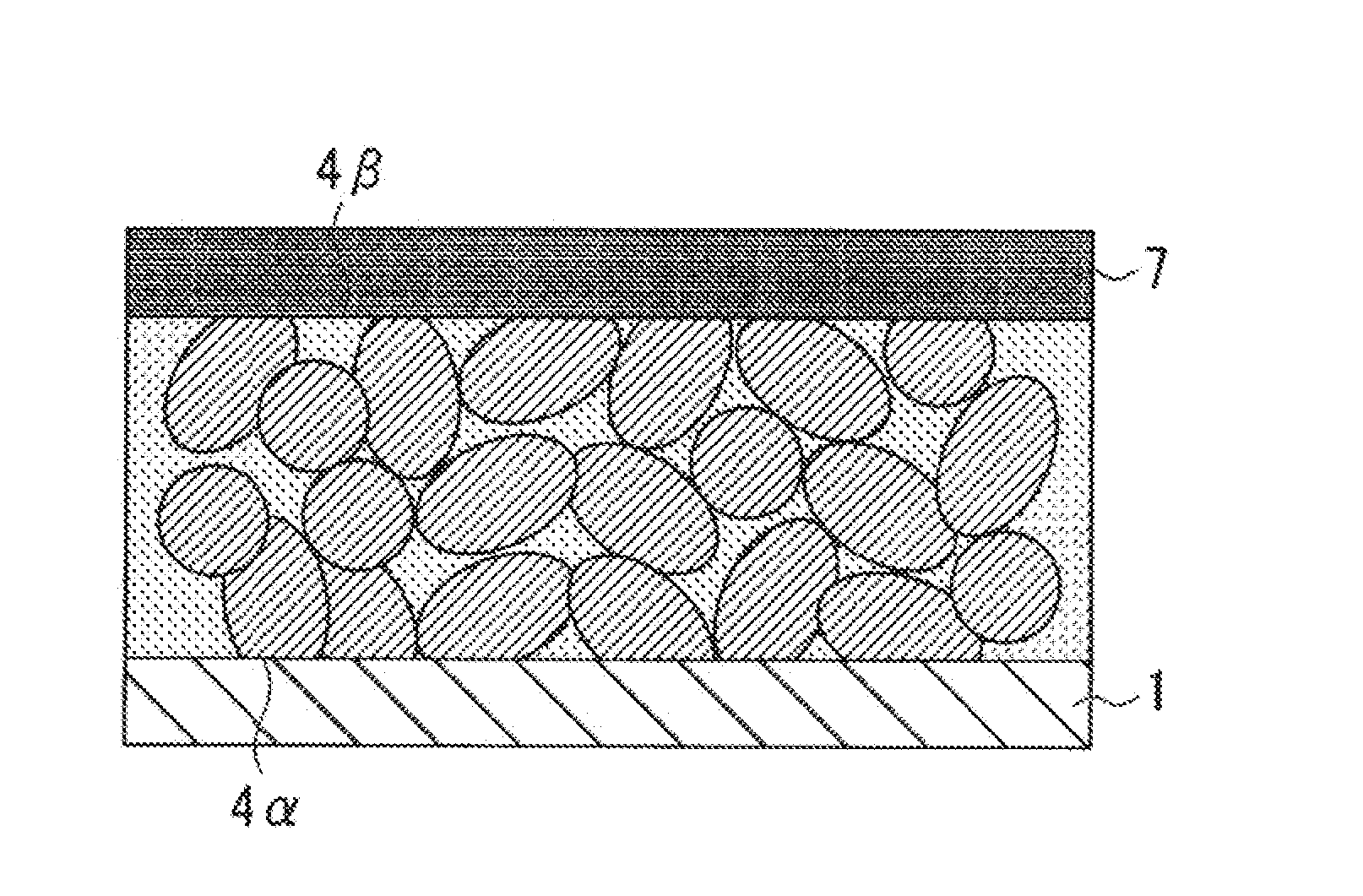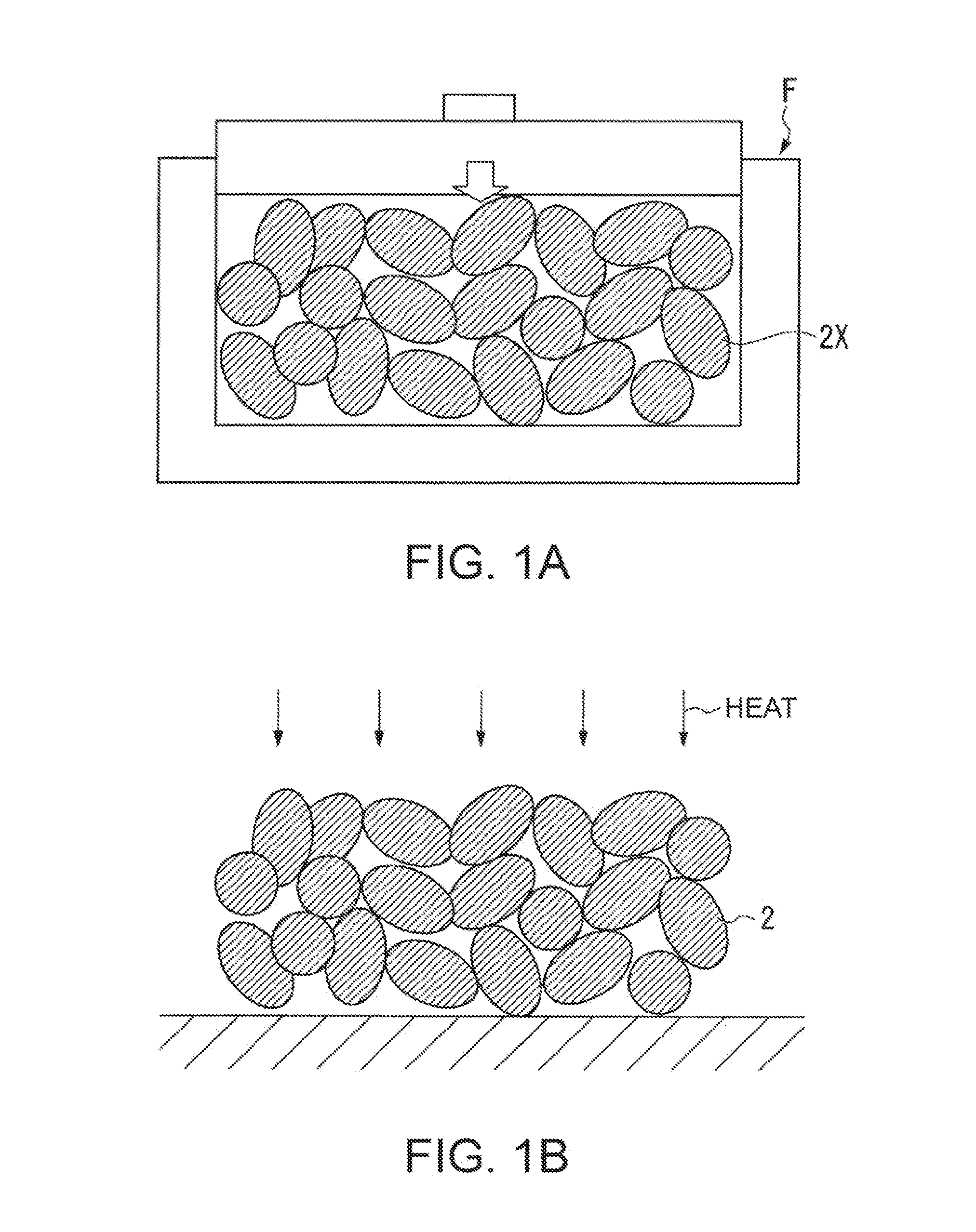Method for producing active material molded body, active material molded body, method for producing lithium battery, and lithium battery
a technology of active materials and molded bodies, which is applied in the direction of cell components, final product manufacturing, sustainable manufacturing/processing, etc., can solve the problems of difficult to exhibit desired conductive properties and deterioration and achieve the reduction of the amount of pore-forming materials, the reduction of the activation energy of the obtained and the control of the porosity of the active material molded body.
- Summary
- Abstract
- Description
- Claims
- Application Information
AI Technical Summary
Benefits of technology
Problems solved by technology
Method used
Image
Examples
modification example 1
[0115]In this embodiment, the solid electrolyte layer 3 is composed of a single layer, however, it does not matter if a solid electrolyte layer is composed of a plurality of layers.
[0116]FIGS. 5 and 6 are cross-sectional side views of a main part showing a modification example of an electrode assembly.
[0117]An electrode assembly 11 shown in FIG. 5 includes a current collector 1, an active material molded body 2, a first electrolyte layer 51 which is composed of a solid electrolyte and is provided in contact with the surface of the active material molded body 2 including the inner surface of each pore of the active material molded body 2, and a second electrolyte layer52 which is provided thinly in contact with the surface of the first electrolyte layer 51. The first electrolyte layer 51 and the second electrolyte layer 52 constitute a solid electrolyte layer 5 as a whole. The solid electrolyte layer 5 is configured such that the volume of the first electrolyte layer 51 is larger tha...
modification example 2
[0123]In this embodiment, after forming the composite body 4 in which the active material molded body 2 and the solid electrolyte layer 3 are combined, the current collector 1 is formed on the formed composite body 4, however, the invention is not limited thereto.
[0124]FIGS. 7A and 7B are process diagrams showing a part of a modification example of a method for producing an electrode assembly.
[0125]In the method for producing an electrode assembly shown in FIGS. 7A and 7B, first, as shown in FIG. 7A, a bulk body 4X of a structure body in which an active material molded body 2 and a solid electrolyte layer 3 are combined is formed, and then, the bulk body 4X is divided into a plurality of segments in accordance with the size of the objective electrode assembly. In FIG. 7A, a division position is indicated by a broken line, and the drawing shows that the bulk body 4X is divided by cleaving in the direction intersecting the longitudinal direction of the bulk body 4X at a plurality of p...
example 1
[0135]100 Parts by mass of LiCoO2 (manufactured by Sigma-Aldrich Co., Ltd., hereinafter referred to as “LCO”) in the form of a powder and 3 parts by mass of polyacrylic acid (manufactured by Sigma-Aldrich Co., Ltd.) in the form of a powder were mixed with each other, whereby a mixed powder of LCO and polyacrylic acid was obtained.
[0136]The Li / Co atomic ratio in the mixed powder as determined by the ICP analysis was 1.01±0.05.
[0137]80 mg of the obtained mixed powder was weighed and placed in a pellet die, and then molded into a disk-shaped pellet having a diameter of 10 mm and a thickness of 0.3 mm by applying a pressure of 624 MPa thereto.
[0138]The thus obtained pellet was fired at 1000° C. in an air atmosphere for 8 hours in a muffle furnace, whereby an active material molded body 1 was obtained.
[0139]The Li / Co atomic ratio in the active material molded body 1 as determined by the ICP analysis was 0.97±0.05.
[0140]The activation energy of the active material molded body 1 was 0.11 e...
PUM
| Property | Measurement | Unit |
|---|---|---|
| temperature | aaaaa | aaaaa |
| partial pressure | aaaaa | aaaaa |
| partial pressure | aaaaa | aaaaa |
Abstract
Description
Claims
Application Information
 Login to View More
Login to View More - R&D
- Intellectual Property
- Life Sciences
- Materials
- Tech Scout
- Unparalleled Data Quality
- Higher Quality Content
- 60% Fewer Hallucinations
Browse by: Latest US Patents, China's latest patents, Technical Efficacy Thesaurus, Application Domain, Technology Topic, Popular Technical Reports.
© 2025 PatSnap. All rights reserved.Legal|Privacy policy|Modern Slavery Act Transparency Statement|Sitemap|About US| Contact US: help@patsnap.com



